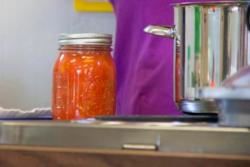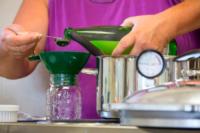Canning Tomatoes
General Information

Tomato fruits, particularly the ripe fruit, is only marginally acidic enough to prevent botulism. This can create some confusion with home canners on the correct process to use. In order to safely can tomatoes always follow a tested recipe. If the recipe calls for the addition of some sort of acid, be sure to follow that instruction.
Generally, highly acidified products like ketchup and salsas with vinegar or bottled lemon or lime juice are usually canned in a water-bath.* Sauces with meats or that do not have acid added will always be pressure canned. It's the more plain products like juice or whole fruit that confuse people.
USDA recommendations for canned tomatoes (juice, whole, crushed, etc.) add a small amount of acid as either citric acid or bottled lemon juice. Additionally they provide options for either water bath or pressure canning. Even if you are pressure canning tomatoes, you are required to add acid in the process. See below for information on how to properly acidify tomatoes.
Why do we add acid? Tomatoes' natural pH hovers right at the margin of safety. It can range from 4.5 to 4.8. (The cut-off is 4.6 for high-acid foods.) While it would be possible to develop a process that is pressure-canning only without adding acid, adding acid allows a shorter processing time and more safety margin in a quality product.
If you use a trusted source like the National Center for Home Food Preservation, So Easy to Preserve, or USDA—and you follow the directions—you should have a safe product.
Tomatoes Separating in Jars
Sometimes the fruit separates from the liquid in canned tomatoes. This occurs from an enzyme active in fresh fruit. By following the directions exactly, even if they seem fussy, this will usually be avoided. Healthy Canning has a good article on this phenomenon.
Separated fruit is still safe to eat, even if it is not pretty.
* Or steam canning, if the processing time is less than 45 minutes at your elevation.
Acidification

Acidification: To ensure safe acidity in whole, crushed, or juiced tomatoes, add 2 tablespoons of bottled lemon juice or 1/2 teaspoon of citric acid per quart of tomatoes. For pints, use 1 tablespoon bottled lemon juice or 1/4 teaspoon citric acid. Acid can be added directly to the jars before filling with product. Add sugar to offset acid taste, if desired. Four tablespoons of a 5 percent acidity vinegar per quart may be used instead of lemon juice or citric acid. However, vinegar may cause undesirable flavor changes.
When a procedure from USDA or NCHFP for canning tomatoes offers both boiling water and pressure canning options, all steps in the preparation are still required even if the pressure processing option is chosen. This includes acidification. The boiling water and pressure alternatives are equal processes with different time/temperature combinations calculated for these products.
Recommendation: Use of a pressure canner will result in higher quality and more nutritious canned tomato products. If your pressure canner cannot be operated above 15 PSI, select a process time at a lower pressure.
From USDA Complete Guide to Home Canning, Vol. 3.
Recipes
These are some popular tested tomato product recipes provided by the National Center for Home Food Preservation.
- Tomato Juice
- Crushed Tomatoes (with no added liquid)
- Standard Tomato Sauce
- Whole or Halved Tomatoes (packed in water)
- Whole or Halved Tomatoes (packed raw without added liquid)
- Spaghetti Sauce without Meat
- Spaghetti Sauce with Meat
- Tomato Ketchup
- Tomato Paste
- Easy Hot Sauce
We recommend following their recipes exactly as written.
Safe Modifications to Tomato Recipes
There are a few safe modifications that can be made to recipes with tomato products. This include:
- You may increase, decrease or omit salt from recipes. It is only there for flavor.
- You may change, add or omit dried spices and seasonings. This is a good way to customize or spice up a simple product like tomato sauce.
- You may change the type of peppers used in a recipe as long as the total volume of peppers and other vegetables must not change. This is a way to increase or decrease spiciness. Replacing jalapeño with serrano peppers will roughly double the spiciness, for example.
This fact sheet from Oregon State University explains safe modifications to salsa in more depth and offers some recipes. Laws of Salsa In addition, NCHFP has a recipe that allows some choices here.
If you have a favorite salsa recipe that is not tested or from a reputable source, we recommend freezing or refrigerating it for long-term storage instead.
